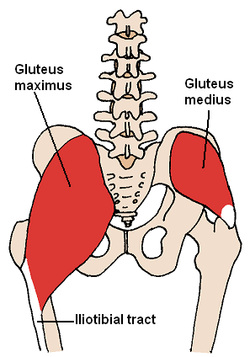Gluteus Medius: Difference between revisions
No edit summary |
No edit summary |
||
| Line 22: | Line 22: | ||
The gluteus medius is supplied by the superior gluteal nerve (root L4, 5 and S1). Cutaneous supply is mainly provided by L1 and 2.<ref name="pala" /> | The gluteus medius is supplied by the superior gluteal nerve (root L4, 5 and S1). Cutaneous supply is mainly provided by L1 and 2.<ref name="pala" /> | ||
= Function | = Function = | ||
Maintaining single-leg stance is required during walking and running. The opposite li | |||
= Assessment = | = Assessment = | ||
Revision as of 21:15, 19 February 2016
Original Editor - Alex Palmer,
Top Contributors - Alex Palmer, George Prudden, Kim Jackson, Ahmed Nasr, Joao Costa, Joanne Garvey, Candace Goh, Nupur Smit Shah, WikiSysop, Vidya Acharya, Pinar Kisacik, Rachael Lowe, Evan Thomas and Kai A. Sigel;
Description[edit | edit source]
Gluteus medius is located on lateral aspect of the upper buttock, below the iliac crest. The superior muscle is broad with the muscle narrowing towards its insertional tendon giving it a fan-shape. Posteriorly, the muscle is overlapped by the gluteus maximus. Gluteus medius is an important muscle in walking, running and single leg weight-bearing.[1] Weakness in this muscle has been associated with lower-limb musculoskeletal pathology[2] and gait disturbance following stroke.[3]
Anatomy[edit | edit source]
Origin[edit | edit source]
Gluteal, or lateral surface of the ilium between the posterior and anterior gluteal lines. This is a large area, reaching from the iliac crest above to the almost the sciatic notch below.[1]
Insertion
[edit | edit source]
Posterior fibres pass forwards and downwards, the middle fibres downwards, anterior fibres pass backwards and downwards. Fibres combine to form a flatterned tendon which attaches to the superlateral side of the greater trochanter of the femur.[1]
Nerve supply[edit | edit source]
The gluteus medius is supplied by the superior gluteal nerve (root L4, 5 and S1). Cutaneous supply is mainly provided by L1 and 2.[1]
Function[edit | edit source]
Maintaining single-leg stance is required during walking and running. The opposite li
Assessment[edit | edit source]
Palpation[edit | edit source]
Power[edit | edit source]
Length[edit | edit source]
Resourses[edit | edit source]
See also[edit | edit source]
Greater trochanteric pain syndrone
Recent Related Research (from Pubmed)[edit | edit source]
References[edit | edit source]
- ↑ 1.0 1.1 1.2 1.3 Palastanga N, Soames R. Anatomy and Human Movement: Structure and Function. 6th ed. London, United Kingdom: Churchill Livingstone; 2012.
- ↑ Barton CJ, Lack S, Malliaras P, Morrissey D. Gluteal muscle activity and patellofemoral pain syndrome: a systematic review. British journal of sports medicine. 2012 Sep 3:bjsports-2012.
- ↑ Buurke JH, Nene AV, Kwakkel G, Erren-Wolters V, IJzerman MJ, Hermens HJ. Recovery of gait after stroke: what changes?. Neurorehabilitation and Neural Repair. 2008 Nov 1;22(6):676-83.







